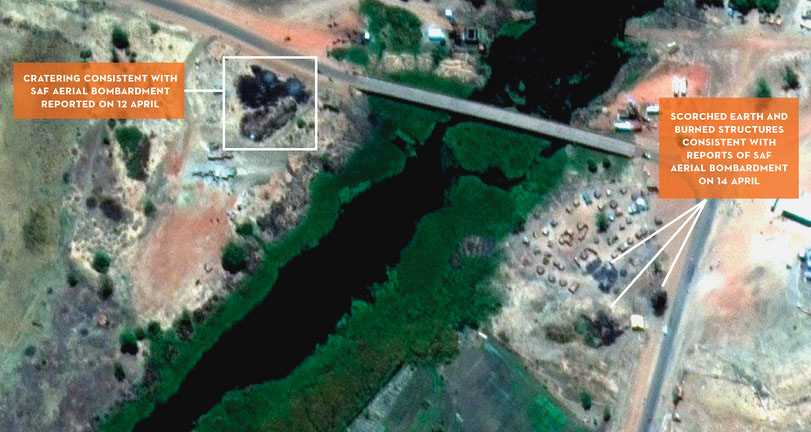
The Satellite Sentinel Project, or SSP, released two new reports, documenting the latest developments in the conflict raging on the border between Sudan and South Sudan.
The conflict has become increasingly violent since the Sudan People’s Liberation Army, or SPLA, advanced on Heglig on April 9. Heglig (known as Panthou to the South Sudanese) is a disputed territory, with both nations claiming that it is within their borders. The area provides an estimated half of Sudan’s oil resources, making it an economically critical location.
The first report “Pipeline: Evidence of the Destruction of Key Oil Infrastructure, Heglig,” published April 22, shows that some type of explosion apparently destroyed an oil collection manifold, which allows oil flows to be separated or combined without interruption. Based on Harvard Humanitarian Initiative analysis of DigitalGlobe satellite imagery, SSP concluded that the damage to this key oil infrastructure will likely stop oil flow in the area.
SSP cannot identify whether aerial bombardments or ground attacks caused the damage, and each army blames the other. On April 15, South Sudan's information minister said, “They [Sudan Armed Forces, or SAF] are bombing the central processing facility and the [oil] tanks to rubble as we speak.” However, on April 21, Sudan’s acting minister of information asserted that the government of Sudan possessed evidence of intentional sabotage to the oil installations carried out by forces of the SPLA as they withdrew from Heglig on April 20.
“This destruction of oil infrastructure benefits neither side,” said Enough Project Executive Director John C. Bradshaw in a statement issued with the release of the SSP report. “To avoid the mutually disastrous consequences of an all-out war, both Sudans must return to the negotiating table to iron out a comprehensive peace deal that resolves the underlying issues, including border demarcation and oil revenue sharing.”
The set of publically available DigitalGlobe satellite imagery depicts cratering consistent with bombardment. Before and after images show the apparent destruction of the oil collection manifold, and tanks, military logistics vehicles (HETs), and heavy equipment transports in the region.
The second report, “Escalation: Evidence of SAF and SPLA Combat Operations,” released April 23, shows a dramatic increase in the number of military strike aircraft at two SAF airbases in range of South Sudan. SSP concluded that the military aircraft identified at Sudan’s airbases in El Obeid, North Kordofan, and Kadugli, South Kordofan, “may represent a significant portion” of SAF’s total combat-capable air assets. Imagery also shows craters consistent with bombardment of an apparent civilian area in Bentiu, the capital of South Sudan’s Unity state.
Though it appears that SAF is on the offensive, neither side appears inculpable. Imagery shows evidence that SPLA and southern-aligned forces looted a SAF military base in Heglig, which is a violation of international law governing the conduct of land warfare.
“This report documents evidence of disregard for basic laws of war by all parties to this widening conflict,” said Harvard Carr Center for Human Rights Policy Executive Director Charlie Clements, MD. “All parties have responsibilities under international law to protect civilian lives and property.”
The region remains tense and both sides in addition to the international community fear that the fighting will spread to engulf a wider swath of the border region.
After the April 9 invasion of Heglig, Sudan declared that it would no longer negotiate with South Sudan. Late on Friday, April 20, President Obama urged the presidents of Sudan and South Sudan to “have the courage to return to the table and negotiate and resolve these issues peacefully." However, Sudan’s president, Omar al-Bashir, responded that there would be "no negotiation with those people [in Juba]." He also engaged in eliminationist rhetoric, vowing to “liberate” South Sudan from the ruling SPLM, which he called “insects.”
Photo: Evidence of aerial bombardment near Rubkona-Bentiu bridge (DigitalGlobe)

